engine Citroen DS5 HYBRID 2016 1.G Repair Manual
[x] Cancel search | Manufacturer: CITROEN, Model Year: 2016, Model line: DS5 HYBRID, Model: Citroen DS5 HYBRID 2016 1.GPages: 376, PDF Size: 12.57 MB
Page 203 of 376
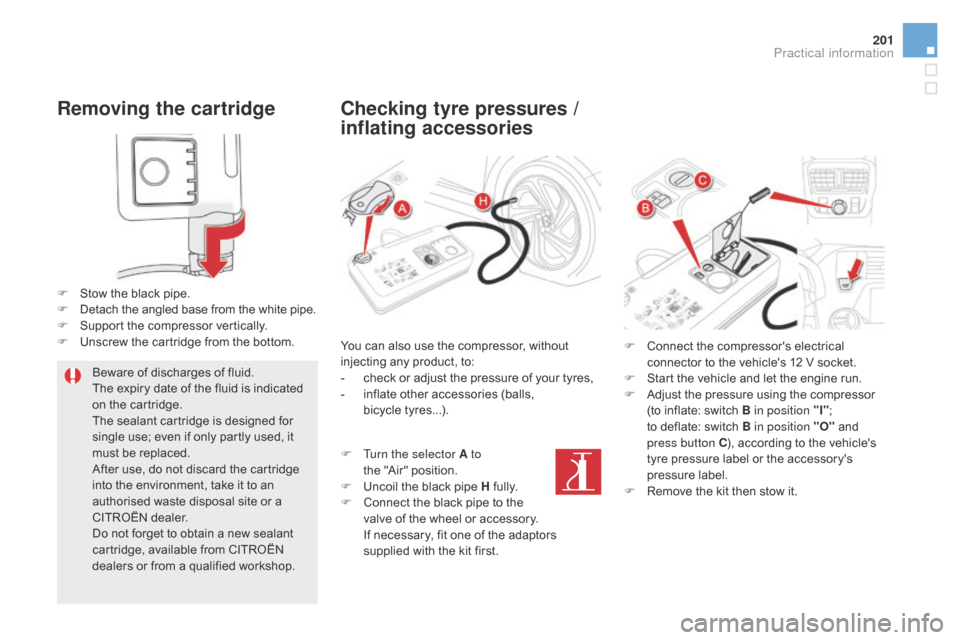
201
DS5_en_Chap08_info-pratiques_ed02-2015
Removing the cartridge
F Stow the black pipe.
F De tach the angled base from the white pipe.
F
Su
pport the compressor vertically.
F
Un
screw the cartridge from the bottom.
Beware of discharges of fluid.
The expiry date of the fluid is indicated
on the cartridge.
The sealant cartridge is designed for
single use; even if only partly used, it
must be replaced.
After use, do not discard the cartridge
into the environment, take it to an
authorised waste disposal site or a
CITROËN dealer.
Do not forget to obtain a new sealant
cartridge, available from CITROËN
dealers or from a qualified workshop.
checking tyre pressures /
i nflating accessories
You can also use the compressor, without
injecting any product, to:
-
ch
eck or adjust the pressure of your tyres,
-
in
flate other accessories (balls,
bicycle
t
yres...).
F
Tu
rn the selector A to
the
"
Air"
p
osition.
F
Un
coil the black pipe H fully.
F
Co
nnect the black pipe to the
valve of the wheel or accessory.
If n
ecessary, fit one of the adaptors
supplied with the kit first. F Co
nnect the compressor's electrical
connector to the vehicle's 12 V socket.
F
St
art the vehicle and let the engine run.
F
Ad
just the pressure using the compressor
(to inflate: switch B in position "I" ;
to
d
eflate: switch B in position "O" and
press button
c), a
ccording to the vehicle's
tyre pressure label or the accessory's
pressure label.
F
Re
move the kit then stow it.
Practical information
Page 224 of 376
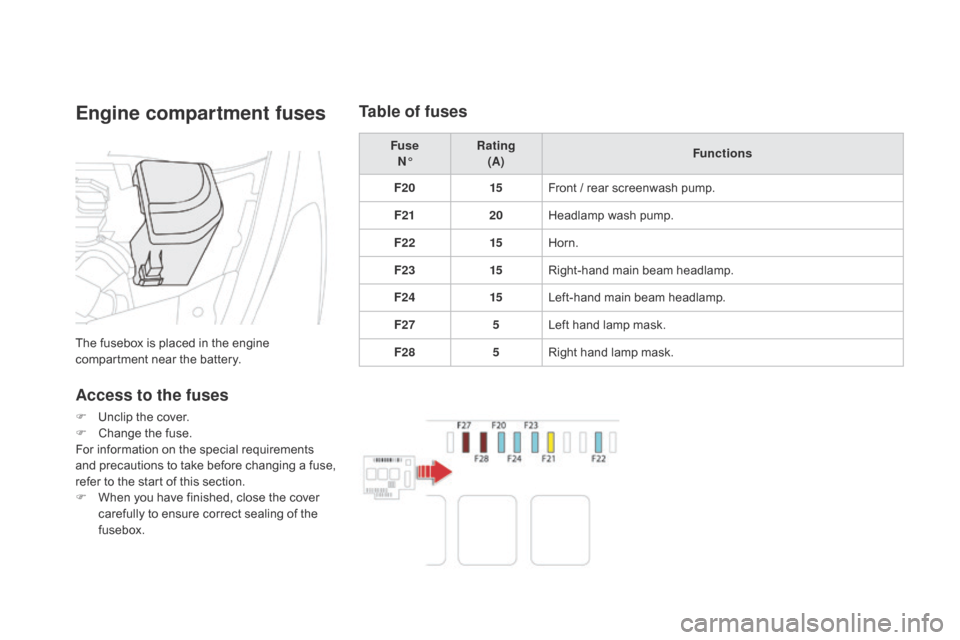
DS5_en_Chap08_info-pratiques_ed02-2015
Engine compartment fuses
The fusebox is placed in the engine
compartment near the battery.
Access to the fuses
F Unclip the cover.
F Ch ange the fuse.
For information on the special requirements
and precautions to take before changing a fuse,
refer to the start of this section.
F
Wh
en you have finished, close the cover
carefully to ensure correct sealing of the
fusebox. Fuse
N° Rating
(A) Functions
F20 15Front / rear screenwash pump.
F21 20Headlamp wash pump.
F22 15Horn.
F23 15Right-hand main beam headlamp.
F24 15Left-hand main beam headlamp.
F27 5Left hand lamp mask.
F28 5Right hand lamp mask.
Table of fuses
Page 225 of 376
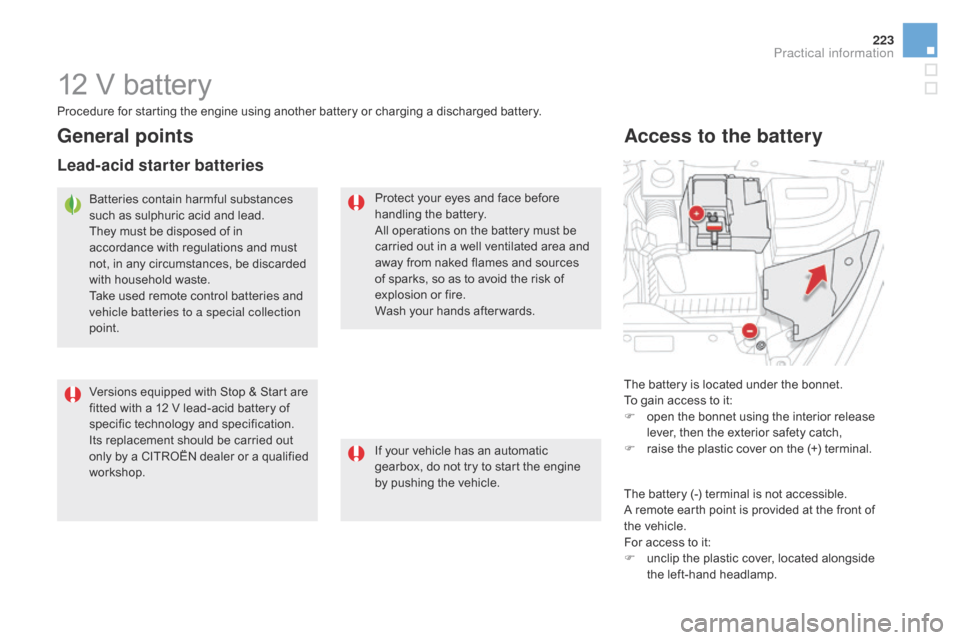
223
DS5_en_Chap08_info-pratiques_ed02-2015
12 V battery
The battery is located under the bonnet.
To gain access to it:
F
op
en the bonnet using the interior release
lever, then the exterior safety catch,
F
ra
ise the plastic cover on the (+) terminal.
Access to the battery
Protect your eyes and face before
handling the battery.
All operations on the battery must be
carried out in a well ventilated area and
away from naked flames and sources
of sparks, so as to avoid the risk of
explosion or fire.
Wash your hands after wards.
Procedure for starting the engine using another battery or charging a discharged battery.
General points
Lead-acid starter batteries
Batteries contain harmful substances
such as sulphuric acid and lead.
They must be disposed of in
accordance with regulations and must
not, in any circumstances, be discarded
with household waste.
Take used remote control batteries and
vehicle batteries to a special collection
point.
If your vehicle has an automatic
gearbox, do not try to start the engine
by pushing the vehicle.
Versions equipped with Stop & Start are
fitted with a 12 V lead-acid battery of
specific technology and specification.
Its replacement should be carried out
only by a CITROËN dealer or a qualified
workshop.
The battery (-) terminal is not accessible.
A remote earth point is provided at the front of
the vehicle.
For access to it:
F
un
clip the plastic cover, located alongside
the left-hand headlamp.
Practical information
Page 226 of 376
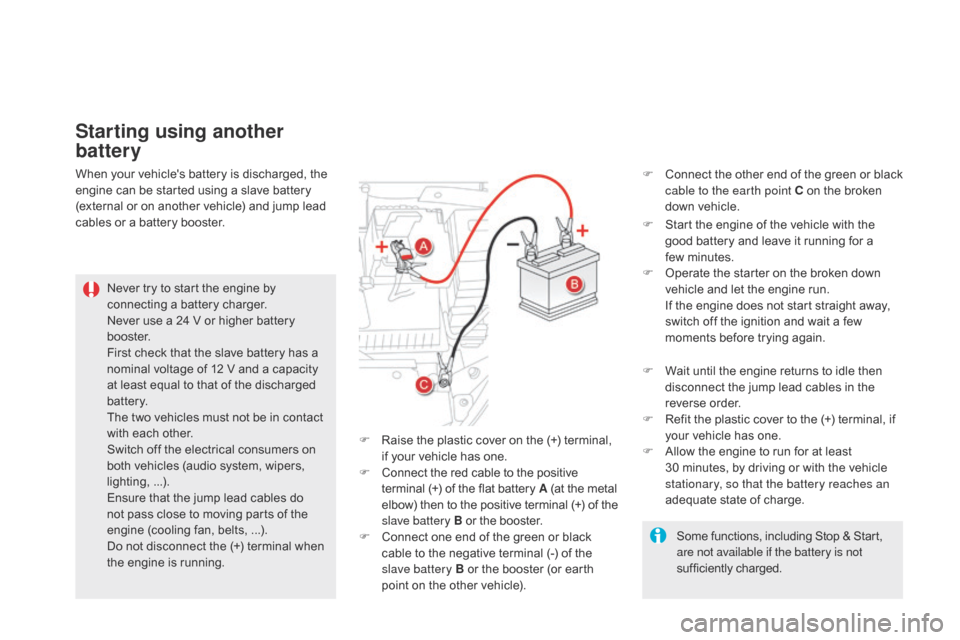
DS5_en_Chap08_info-pratiques_ed02-2015
Starting using another
battery
Never try to start the engine by
connecting a battery charger.
Never use a 24 V or higher battery
b o o s t e r.
First check that the slave battery has a
nominal voltage of 12 V and a capacity
at least equal to that of the discharged
battery.
The two vehicles must not be in contact
with each other.
Switch off the electrical consumers on
both vehicles (audio system, wipers,
lighting, ...).
Ensure that the jump lead cables do
not pass close to moving parts of the
engine (cooling fan, belts, ...).
Do not disconnect the (+) terminal when
the engine is running.F
St
art the engine of the vehicle with the
good battery and leave it running for a
few
mi
nutes.
F Op erate the starter on the broken down
vehicle and let the engine run.
If t
he engine does not start straight away,
switch off the ignition and wait a few
moments before trying again.
When your vehicle's battery is discharged, the
engine can be started using a slave battery
(external or on another vehicle) and jump lead
cables or a battery booster.
F
Wa
it until the engine returns to idle then
disconnect the jump lead cables in the
reverse order.
F
Re
fit the plastic cover to the (+) terminal, if
your vehicle has one.
F
Al
low the engine to run for at least
30
m
inutes, by driving or with the vehicle
stationary, so that the battery reaches an
adequate state of charge.
F
Ra
ise the plastic cover on the (+) terminal,
if your vehicle has one.
F
Co
nnect the red cable to the positive
terminal (+) of the flat battery A (at the metal
elbow) then to the positive terminal
(
+) of the
slave battery B or the booster.
F
Co
nnect one end of the green or black
cable to the negative terminal (-) of the
slave battery B or the booster (or earth
point on the other vehicle). Some functions, including Stop & Start,
are not available if the battery is not
sufficiently charged.
F
Co
nnect the other end of the green or black
cable to the earth point
c o
n the broken
down vehicle.
Page 228 of 376
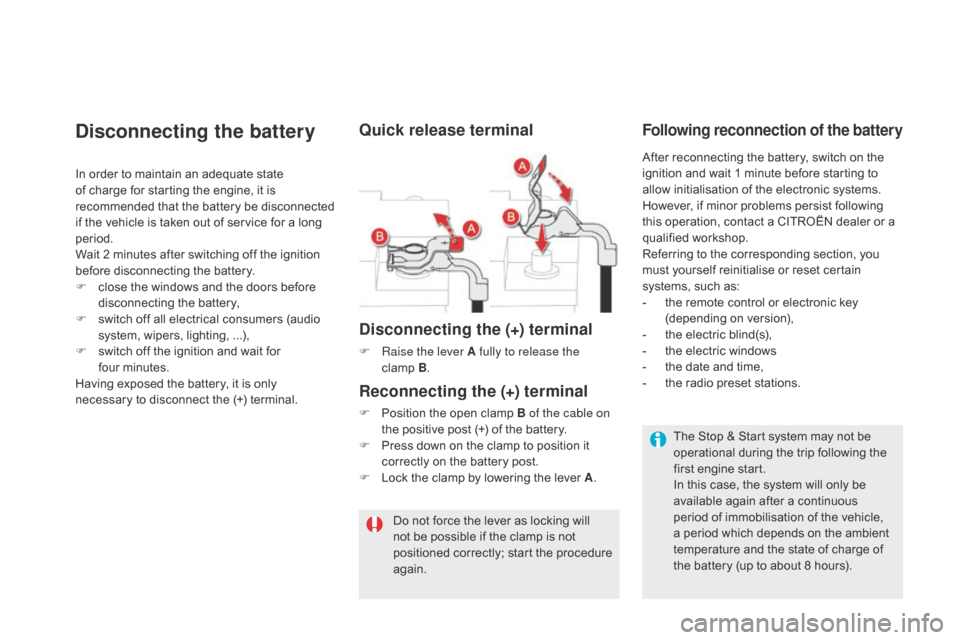
DS5_en_Chap08_info-pratiques_ed02-2015
disconnecting the battery
In order to maintain an adequate state
of charge for starting the engine, it is
recommended that the battery be disconnected
if the vehicle is taken out of service for a long
period.
Wait 2 minutes after switching off the ignition
before disconnecting the battery.
F
cl
ose the windows and the doors before
disconnecting the battery,
F
sw
itch off all electrical consumers (audio
system, wipers, lighting, ...),
F
sw
itch off the ignition and wait for
four
mi
nutes.
Having exposed the battery, it is only
necessary to disconnect the (+) terminal.
Quick release terminal
dis
connecting the (+) terminal
F Raise the lever A fully to release the
c lamp B.
Following reconnection of the battery
Reconnecting the (+) terminal
F Position the open clamp B of the cable on
t
he positive post (+) of the battery.
F
Pr
ess down on the clamp to position it
correctly on the battery post.
F
Lo
ck the clamp by lowering the lever A .
Do not force the lever as locking will
not be possible if the clamp is not
positioned correctly; start the procedure
again. The Stop & Start system may not be
operational during the trip following the
first engine start.
In this case, the system will only be
available again after a continuous
period of immobilisation of the vehicle,
a period which depends on the ambient
temperature and the state of charge of
the battery (up to about 8 hours).
After reconnecting the battery, switch on the
ignition and wait 1 minute before starting to
allow initialisation of the electronic systems.
However, if minor problems persist following
this operation, contact a CITROËN dealer or a
qualified workshop.
Referring to the corresponding section, you
must yourself reinitialise or reset certain
systems, such as:
-
th
e remote control or electronic key
(depending on version),
-
th
e electric blind(s),
-
th
e electric windows
-
th
e date and time,
-
th
e radio preset stations.
Page 229 of 376
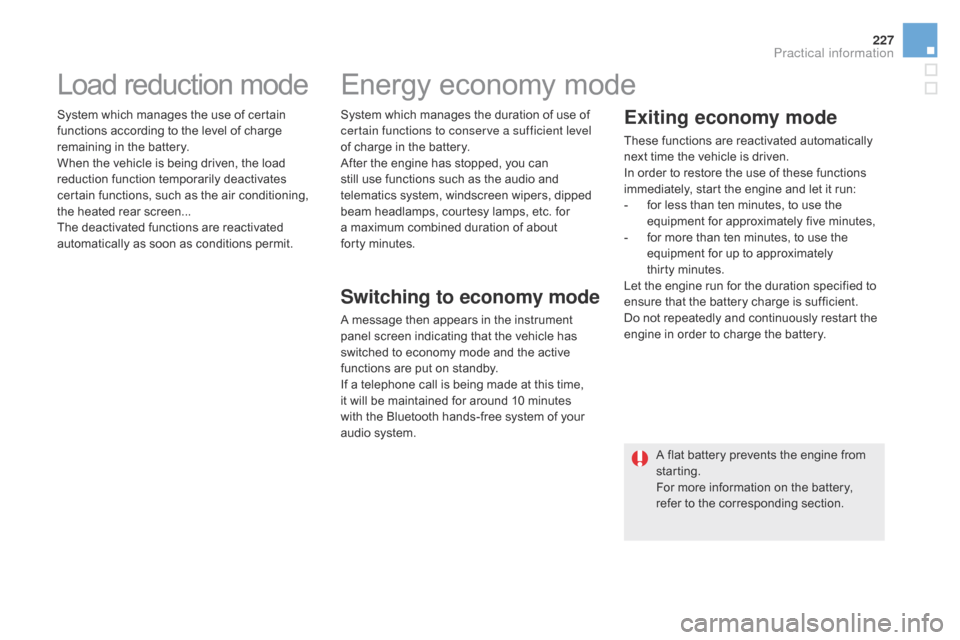
227
DS5_en_Chap08_info-pratiques_ed02-2015
Load reduction mode
System which manages the use of certain
functions according to the level of charge
remaining in the battery.
When the vehicle is being driven, the load
reduction function temporarily deactivates
certain functions, such as the air conditioning,
the heated rear screen...
The deactivated functions are reactivated
automatically as soon as conditions permit.System which manages the duration of use of
certain functions to conserve a sufficient level
of charge in the battery.
After the engine has stopped, you can
still use functions such as the audio and
telematics system,
w
indscreen wipers, dipped
beam headlamps,
c
ourtesy lamps, etc. for
a maximum combined duration of about
forty
mi
nutes.
Energy economy mode
Switching to economy mode
A message then appears in the instrument
panel screen indicating that the vehicle has
switched to economy mode and the active
functions are put on standby.
If a telephone call is being made at this time,
it
w
ill be maintained for around 10 minutes
with the Bluetooth hands-free system of your
audio
s
ystem.
Exiting economy mode
These functions are reactivated automatically
next time the vehicle is driven.
In order to restore the use of these functions
immediately, start the engine and let it run:
-
fo
r less than ten minutes, to use the
equipment for approximately five minutes,
-
fo
r more than ten minutes, to use the
equipment for up to approximately
thirty
mi
nutes.
Let the engine run for the duration specified to
ensure that the battery charge is sufficient.
Do not repeatedly and continuously restart the
engine in order to charge the battery.
A flat battery prevents the engine from
starting.
For more information on the battery,
refer to the corresponding section.
Practical information
Page 231 of 376
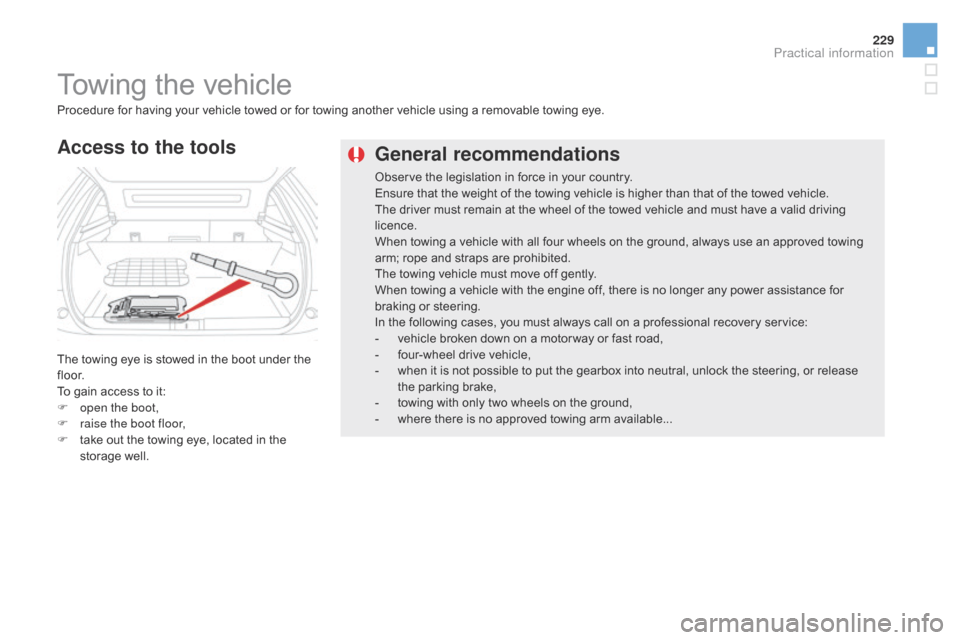
229
DS5_en_Chap08_info-pratiques_ed02-2015
General recommendations
Observe the legislation in force in your country.
Ensure that the weight of the towing vehicle is higher than that of the towed vehicle.
The driver must remain at the wheel of the towed vehicle and must have a valid driving
licence.
When towing a vehicle with all four wheels on the ground, always use an approved towing
arm; rope and straps are prohibited.
The towing vehicle must move off gently.
When towing a vehicle with the engine off, there is no longer any power assistance for
braking or steering.
In the following cases, you must always call on a professional recovery service:
-
ve
hicle broken down on a motor way or fast road,
-
fo
ur-wheel drive vehicle,
-
wh
en it is not possible to put the gearbox into neutral, unlock the steering, or release
the parking brake,
-
to
wing with only two wheels on the ground,
-
wh
ere there is no approved towing arm available...
Towing the vehicle
Access to the tools
The towing eye is stowed in the boot under the
f l o o r.
To gain access to it:
F
op
en the boot,
F
ra
ise the boot floor,
F
ta
ke out the towing eye, located in the
storage well.
Procedure for having your vehicle towed or for towing another vehicle using a removable towing eye.
Practical information
Page 232 of 376
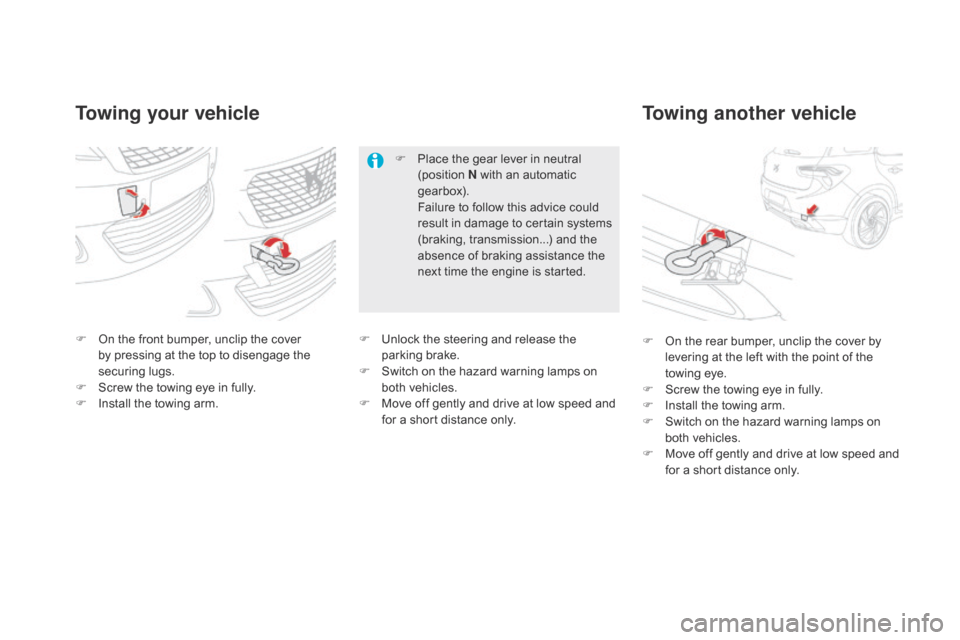
DS5_en_Chap08_info-pratiques_ed02-2015
Towing your vehicleTowing another vehicle
F On the front bumper, unclip the cover
b
y pressing at the top to disengage the
securing lugs.
F
Sc
rew the towing eye in fully.
F
In
stall the towing arm. F On t
he rear bumper, unclip the cover by
levering at the left with the point of the
towing eye.
F
Sc
rew the towing eye in fully.
F
In
stall the towing arm.
F
Sw
itch on the hazard warning lamps on
both vehicles.
F
Mov
e off gently and drive at low speed and
for a short distance only.
F
Pl
ace the gear lever in neutral
(position N with an automatic
gearbox).
Fa
ilure to follow this advice could
result in damage to certain systems
(braking, transmission...) and the
absence of braking assistance the
next time the engine is started.
F Un lock the steering and release the
parking brake.
F
Sw
itch on the hazard warning lamps on
both vehicles.
F
Mov
e off gently and drive at low speed and
for a short distance only.
Page 240 of 376
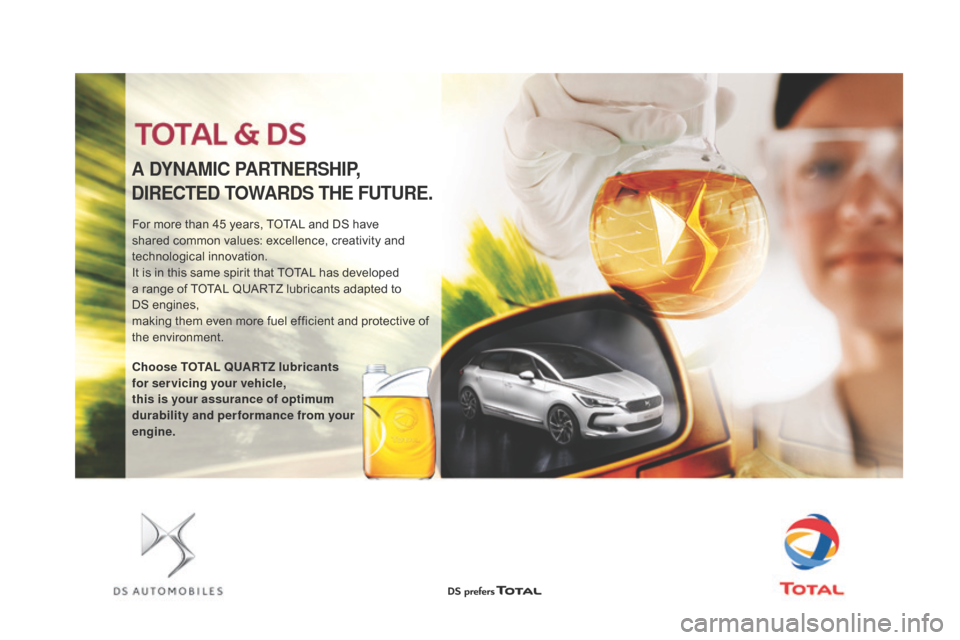
DS5_en_Chap09_verifications_ed02-2015
For more than 45 years, TOTAL and DS have
shared common values: excellence, creativity and
technological innovation.
It is in this same spirit that TOTAL has developed
a range of TOTAL QUARTZ lubricants adapted to
DS
e
ngines,
making them even more fuel efficient and protective of
the environment.
cho
ose TOTAL QUARTZ lubricants
for servicing your vehicle,
this is your assurance of optimum
durability and per formance from your
engine.
A dYNAMIc P ARTNERSHIP,
dIR
E
cTEd T
OWAR
dS TH
E FUTURE.
Page 241 of 376
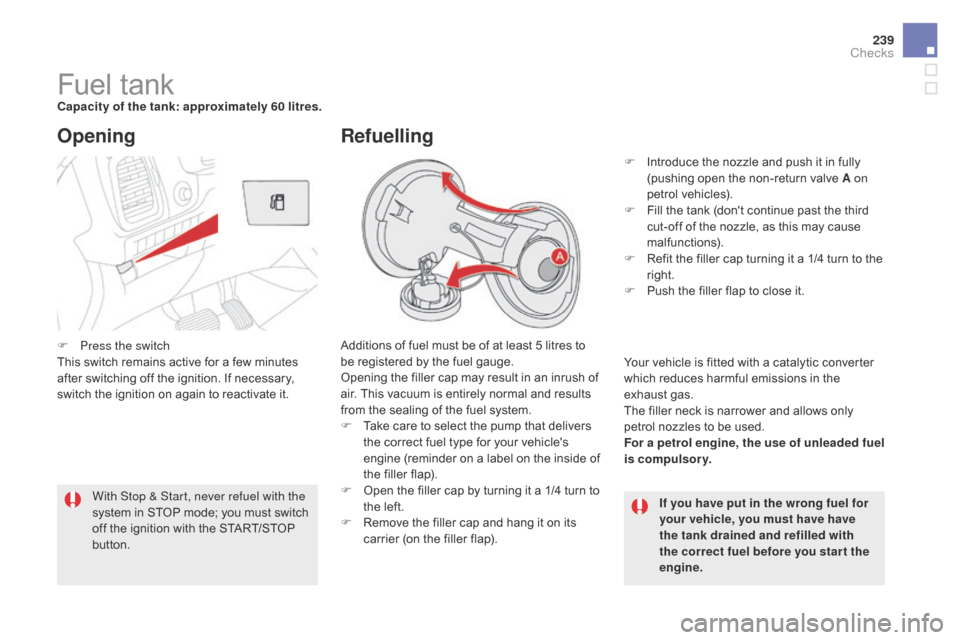
239
DS5_en_Chap09_verifications_ed02-2015
Fuel tankcapacity of the tank: approximately 60 litres.A dditions of fuel must be of at least 5 litres to
be registered by the fuel gauge.
Opening the filler cap may result in an inrush of
air. This vacuum is entirely normal and results
from the sealing of the fuel system.
F
Ta
ke care to select the pump that delivers
the correct fuel type for your vehicle's
engine (reminder on a label on the inside of
the filler flap).
F
Op
en the filler cap by turning it a 1/4 turn to
the left.
F
Re
move the filler cap and hang it on its
carrier (on the filler flap).
Opening
If you have put in the wrong fuel for
your vehicle, you must have have
the tank drained and refilled with
the correct fuel before you star t the
engine.
With Stop & Start, never refuel with the
system in STOP mode; you must switch
off the ignition with the START/STOP
button.
Refuelling
F Introduce the nozzle and push it in fully
(
pushing open the non-return valve A on
petrol vehicles).
F
Fi
ll the tank (don't continue past the third
cut-off of the nozzle, as this may cause
malfunctions).
F
Re
fit the filler cap turning it a 1/4 turn to the
right.
F
Pu
sh the filler flap to close it.
Your vehicle is fitted with a catalytic converter
which reduces harmful emissions in the
exhaust gas.
The filler neck is narrower and allows only
petrol nozzles to be used.
For a petrol engine, the use of unleaded fuel
is compulsory.
F
Pr
ess the switch
This switch remains active for a few minutes
after switching off the ignition. If necessary,
switch the ignition on again to reactivate it.
checks